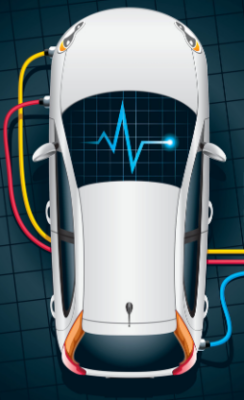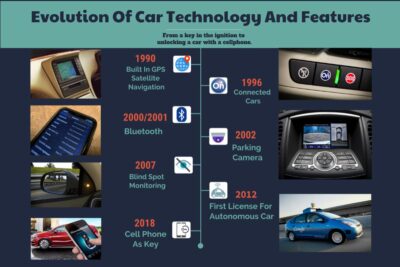
Monthly Content Summary
This month we've got an information-heavy newsletter that discusses the history of scan tools and the diagnostic industry.
Autel has settled a data theft lawsuit and will pay $33.4 million.
We share with you some information on top challenges in the industry.
And our tech tip discusses some useful features like data logging o the Zenith-5 and iScan 3.
Article Index
⚙️The Evolution of Automotive Diagnostic Scan Tools
⚙️Top Diagnostic Challenges in 2024
⚙️Autel Settles Proprietary Data Theft Suit for $33.62 Million
⚙️Tech Tip: Maximizing Scan Tool Efficiency
The Evolution of Automotive Diagnostic Scan Tools
From humble beginnings with basic code readers to today's advanced diagnostic tools, the evolution of automotive diagnostics has been nothing short of remarkable. It's a journey that has mirrored the rapid advancements in automotive technology, adapting and evolving to meet the needs of modern vehicles.
The revolution began in the 1960s and '70s with the first simple diagnostic tools, which were a major leap forward, allowing mechanics to diagnose issues without the need for extensive manual testing. The introduction of On-Board Diagnostics (OBD) in the 1980s was a game-changer, standardizing diagnostic trouble codes (DTCs) and making problem identification more efficient.
The shift to OBD-II in the mid-1990s brought about universal diagnostic methods for all cars, enhancing diagnostic capabilities and monitoring a broader range of vehicle systems. The digital era has taken these tools further, enabling real-time performance monitoring, predictive maintenance, and seamless updates through wireless connectivity.
Looking ahead, the future of automotive diagnostics is bright and boundless, especially with the advent of electric vehicles (EVs) and autonomous driving technologies. The potential integration of artificial intelligence and machine learning promises even more sophisticated diagnostic capabilities, paving the way for a future where vehicles can diagnose themselves and perhaps even drive themselves to the mechanic for service.
The evolution of diagnostic tools is a testament to the incredible journey of automotive technology, and it's an exciting time to be part of this industry! If you're interested in the latest technology in automotive diagnostic scan tools, call your CAS rep.
Top Diagnostic Challenges in 2024
 As we shift gears into 2024, the automotive diagnostic landscape continues to evolve at an unprecedented pace keeping up with technology. We're spotlighting the top diagnostic challenges that professionals like you and your technicians will face.
As we shift gears into 2024, the automotive diagnostic landscape continues to evolve at an unprecedented pace keeping up with technology. We're spotlighting the top diagnostic challenges that professionals like you and your technicians will face.
1. Advanced Driver Assistance Systems (ADAS) Calibration
The integration of ADAS in modern vehicles brings a new layer of complexity to diagnostics and repairs. From adaptive cruise control to lane-keeping assist, it's important to make sure all sensors are recalibrated after repairs or crashes. The challenge here is each manufacturer has unique calibration requirements, making it important for technicians to know each manufacturer's specifications.
Consider equipping your shop with a tool that allows you to gain access to remote diagnostic support. The iScan3 has Support-On-Demand and the Zenith 5 uses EZ-Remote.
2. Electric and Hybrid Vehicle Diagnostics
The widespread increase in electric and hybrid vehicles introduces new diagnostic challenges from battery management systems to high-voltage circuitry. The main hurdle here is the specialized knowledge and equipment required to safely diagnose and repair these vehicles.
3. Secure Gateway (SGW) Access (Two-Factor Authentication)
Manufacturers are increasingly implementing SGW modules to protect vehicle data, posing a challenge for aftermarket diagnostics. Gaining access to perform diagnostics or updates requires authorization which can slow down or complicate the repair process for independent shops.
4. Software Updates and Flash Programming
As vehicles become more software-driven, the need for regular updates and flash programming becomes more critical—and more complex. The challenge lies in keeping up with the constant flow of software updates from manufacturers.
Additionally, keeping a written down notepad of usernames and passwords, as well as a list of the last update, ensures your tools stay accessible and up-to-date.
For questions on tools or software we offer, call us at 1 (877) 263-4897 or visit us at OEMtools.com!
Autel Settles Proprietary Data Theft Suit for $33.62 Million
In a landmark settlement within the automotive industry, Autel Corporation and its New York affiliate have agreed to pay $33.62 million to Mitchell Repair Information Company and Snap-on.
This agreement concludes a lawsuit accusing Autel of unlawfully using proprietary data to enhance their MaxiSys Ultra product, a claim that underscores the intense competition and the high value placed on diagnostic data and technology.
The conflict began when Mitchell and Snap-on, both leaders in automotive diagnostic and repair information, alleged that Autel had engaged in unauthorized use of their exclusive data. This data, accumulated over more than 25 years through expert and AI analysis, represents billions of data points critical to the companies' operations.
The lawsuit detailed three primary methods Autel allegedly used to access this proprietary information:
Bypassing Security Measures: Autel was accused of circumventing security on Mitchell 1 and Snap-on diagnostic tools to perform mass downloads of proprietary data.
Unauthorized Access: It was alleged that Autel used login credentials from another company to systematically access data from Mitchell's TruckSeries product.
License Agreement Violations: Autel was also accused of breaching end-user license agreements to download large quantities of data from Mitchell 1’s ProDemand product.
The lawsuit further highlighted Autel's attempts to mask its activities, including the use of over 300 IP addresses and mimicking Snap-on device authentication information. A significant incident cited was an abnormal surge in data requests to Snap-on’s servers, with millions of queries over a short period, suggesting systematic data extraction.
You can read original source articles for this information by clicking the links below:
Tech Tip - ATTN: Maximizing Scan Tool Efficiency
There’s no replacing skill and education, but knowing what your tools can do is always going to improve your current diagnostic challenge and those that you come up against in the future. At CAS we offer many types of scan tools for many different lines, but for the purpose of this tech tip we’re going to focus on two: The Zenith 5 and the iScan 3.
Zenith 5
1. Custom Data Lists: The Zenith 5 allows you to create custom data lists. This means you can monitor specific parameters relevant to the diagnostic to streamline the process and focus on the data that matters most.
- Accessing Data Lists:
- From the main menu, select the vehicle you're working on.
- Navigate to the "Data Stream" or "Live Data" section.
- Here, you'll see an option to view or customize data lists.
- Creating Custom Lists:
- Look for an option like "Create New List" or "Customize Data List."
- Select the parameters you want to include by checking their boxes or adding them to your list.
- Save the list with a name you'll remember for easy access later.
2. Graphing Multiple PIDs: The Zenith 5 is able to graph multiple PIDs (Parameter IDs) simultaneously by comparing the behaviors of different sensors in real-time, you can pinpoint issues that might not be evident when viewed individually.
- Selecting PIDs to Graph:
- Within the "Live Data" section, after choosing your custom or pre-set data list, look for an option to graph the data.
- You may need to select specific PIDs you want to graph. This can usually be done by checking boxes next to each PID or selecting them from a list.
- Viewing Graphs:
- After selecting, there should be an option to start graphing. The tool will display real-time graphs for the chosen PIDs.
- You can often adjust the scale or time frame for each graph for better analysis.
3. Freeze Frame Data Analysis: While accessing freeze frame data is a common practice, the Zenith 5 offers an in-depth analysis feature that provides insights into the conditions leading up to a fault code being set.
- Accessing Freeze Frame Data:
- From the vehicle's main diagnostic menu, navigate to the "Trouble Codes" or "DTCs" section.
- Select a code to view more details, and look for an option to view the freeze frame data associated with that code.
- Analyzing Data:
- The freeze frame data will be displayed, showing the conditions (speed, engine, temperature, etc.) at the time the code was set.
- Use the tool's analysis features, if available, to interpret this data. This might include comparing it to normal operating parameters or using built-in troubleshooting guides.
4. Logging data from sessions: If you have repeat customers or a consistent issue, you can log the data in order to be able to view it at a later time. This can be helpful in other diagnostics, with returning customers, or just to review it with technicians who need to learn how to handle an issue.
- Starting a Session Log:
- Look for a "Session Log" or "Record Session" option in the tool's main menu or within the diagnostic session screen.
- Activate this feature to begin recording the diagnostic session.
- Saving and Reviewing Logs:
- Once you've completed your diagnostics, stop the recording. You'll be prompted to save the session with a name or timestamp.
- To review saved sessions, navigate to the "Session Logs" or "Saved Sessions" area from the main menu, where you can select and review previous logs.
iScan 3
1. Advanced Coding and Programming: The iScan 3 is particularly adept at coding and programming, offering a significant advantage for servicing European vehicles. This feature allows for software updates and module programming directly through the tool.
- Accessing Coding and Programming:
- From the main menu, select the vehicle you're working on.
- Navigate to the "Coding" or "Programming" section, which might be under vehicle-specific options or advanced diagnostics.
- You'll find options for module identification, software updates, or component programming.
- Performing Coding/Programming:
- Follow the on-screen instructions to select the module or software you wish to update or code.
- The tool may guide you through the process, including any necessary preconditions or steps to complete the programming successfully.
- Confirm the changes and complete the process, ensuring the vehicle's systems are up to date or correctly coded.
2. Remote Diagnostics with SOD: Support-On-Demand (SOD) offers opportunities for remote work and expert consultation, enhancing both immediate diagnostic capabilities and broader knowledge.
- SOD for Remote Diagnostics:
- Within the iScan 3 interface, look for the SOD or remote diagnostics option, often found in the tool's main or diagnostic menu.
- Initiate an SOD session, which may require entering specific vehicle information or diagnostic issues you're facing.
- Connect with an expert or technician remotely, allowing them to assist with diagnostics.
- Schedule an online session with our expert CAS EZ-Remote operator and we’ll provide remote support; simply call '83 EZ-Remote' (833-397-3668) between 8:30 am and 5:00 pm EST, Monday to Friday. Pay a single session fee, and you're set!
3. Bi-Directional Control for In-Depth Testing: Utilizing bi-directional control allows for direct testing of vehicle components, streamlining the diagnostic process by enabling actions directly from the tool without manual intervention.
- Accessing Bi-Directional Control:
- From the vehicle diagnostic menu, select the "Bi-Directional Control" or "Active Test" option.
- Choose the system or component you wish to test. The tool will list available tests or actions that can be performed.
- Performing Tests:
- Select the test or action you want to perform. The iScan 3 will provide instructions or automatically initiate the test.
- Monitor the results directly on the tool, assessing the component's performance or diagnosing issues based on the test outcomes.


